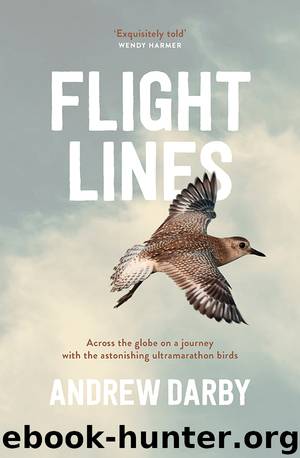Flight Lines by Andrew Darby

Author:Andrew Darby
Language: eng
Format: epub
Publisher: Allen & Unwin
Published: 2019-12-09T16:00:00+00:00
In the great winter migration down the north-western Pacific coast of the EAAF, the Sea of Okhotsk offers some of the earliest riches. Dozens of sites fringing Japan are also targets for birds that do not wait for the Yellow Sea. But for one Beringian migrant there is no such choice. To it, the ocean is a highway south, though it cannot settle. Instead it makes the longest non-stop flight by any land bird.
Bob Gill was new to Alaska and out on the Yukon–Kuskokwim Delta in the 1970s when he first saw this bird. He thought of it then as an almost mythical Asian–Alaskan creature that somehow showed up in Australia and New Zealand.
‘I have one vivid recollection of waking up, in post-breeding season, and suddenly there’s a flock of thousands of Bar-tailed Godwits right in front of me. I’d never seen them before. Big storm comes, we hunker down in a cabin, we wake up next day and they’re gone. Not only are they gone, but these guys were fat. Unbelievably fat.
‘Now if you’re going over the coast to Asia, which is just a hop, step and jump, why are you carrying all this fat? It’s counter intuitive. Then you start looking at the storms. Well these birds left when they had a massive tailwind that would take them right south in the Pacific. So that was my first exposure, and things just went from there …’
The work Gill led, first with Mark Barter but mainly in a long collaboration with New Zealand researchers, stands as a landmark in global understanding of shorebird powers. As new techniques emerged, these scientists often used them most dramatically to illuminate the exceptional feats of the Bar-tailed Godwit’s baueri sub-species. From this comes a vivid understanding of many shorebirds’ long migratory flights.
The baueri godwit’s breeding grounds spread widely along terrain inland from the coast of Alaska, from the delta up the Bering Strait and around the North Slope to the Arctic Sea. Gill has found nests buried in dense shrubs, and others out in open grassland. In general they are cryptic breeders, hard to study. But no matter how far apart they nest, it appears they all gather at the Yukon–Kuskokwim in the late summer and autumn to feed up before their southward migration. They arrive there in waves, the most northerly birds last.
Like their flyway counterparts—the menzbieri godwits that I saw disappear into indigo north-west Australian evening skies—these baueri birds coalesce into excited, chattering flocks when they are in the delta. To the Yup’ik people of the Yukon–Kuskokwim, the bird is Tevatevaaq (de-vaah-dev’aahq). Emblematic of the godwit cry, this name is collected in an absorbing study of Alaskan natives lives with shorebirds by Department of Fish and Game researchers Liliana Naves and Jacqueline Keating. They found Tevatevaaq is also Sugg’erpak (sooggh’erh-buck), one of a group of long-billed shorebirds. As these birds gather and swirl in flocks, they become Puyunaq (boo-yoo’naq)—like smoke in the sky.
Naves and Keating spent years in face-to-face research discovering Indigenous knowledge of shorebirds, and assessing the level of hunting.
Download
This site does not store any files on its server. We only index and link to content provided by other sites. Please contact the content providers to delete copyright contents if any and email us, we'll remove relevant links or contents immediately.
Sapiens: A Brief History of Humankind by Yuval Noah Harari(13920)
The Tidewater Tales by John Barth(12372)
Mastermind: How to Think Like Sherlock Holmes by Maria Konnikova(6895)
Do No Harm Stories of Life, Death and Brain Surgery by Henry Marsh(6659)
The Thirst by Nesbo Jo(6407)
Why We Sleep: Unlocking the Power of Sleep and Dreams by Matthew Walker(6301)
Life 3.0: Being Human in the Age of Artificial Intelligence by Tegmark Max(5147)
Sapiens by Yuval Noah Harari(5094)
The Longevity Diet by Valter Longo(4835)
The Body: A Guide for Occupants by Bill Bryson(4539)
The Rules Do Not Apply by Ariel Levy(4485)
The Immortal Life of Henrietta Lacks by Rebecca Skloot(4224)
Why We Sleep by Matthew Walker(4171)
Animal Frequency by Melissa Alvarez(4126)
Yoga Anatomy by Kaminoff Leslie(4085)
The Hacking of the American Mind by Robert H. Lustig(4051)
All Creatures Great and Small by James Herriot(3951)
Barron's AP Biology by Goldberg M.S. Deborah T(3925)
Double Down (Diary of a Wimpy Kid Book 11) by Jeff Kinney(3874)
